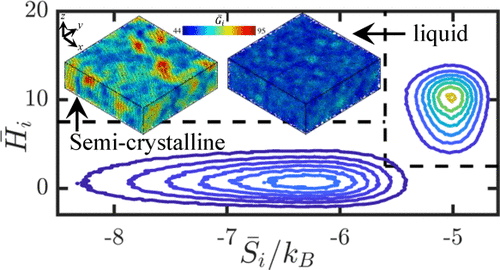当前位置:
X-MOL 学术
›
Macromolecules
›
论文详情
Our official English website, www.x-mol.net, welcomes your
feedback! (Note: you will need to create a separate account there.)
A Thermodynamically Inspired Method for Quantifying Phase Transitions in Polymeric Liquids with Application to Flow-Induced Crystallization of a Polyethylene Melt
Macromolecules ( IF 5.1 ) Pub Date : 2020-11-24 , DOI: 10.1021/acs.macromol.0c02144 Mohammad Hadi Nafar Sefiddashti 1 , Brian J. Edwards 1 , Bamin Khomami 1
Macromolecules ( IF 5.1 ) Pub Date : 2020-11-24 , DOI: 10.1021/acs.macromol.0c02144 Mohammad Hadi Nafar Sefiddashti 1 , Brian J. Edwards 1 , Bamin Khomami 1
Affiliation

|
Thermodynamic-like local atomistic entropy and enthalpy variables are introduced as a means to delineate and quantify phase transitions in atomistic simulations of extensional flow of an entangled polyethylene melt. These variables measure the local ordering and energetics at the monomer level, as opposed to the global system, and hence can be used to detect and quantify flow-enhanced nucleation events on small length and time scales that lead to flow-induced crystallization. The kinetics of the nucleating localized crystals can also be tracked using an atomistic Gibbs free energy composite variable. Based on the assumption that the global crystallization process followed a first-order reversible kinetic rate expression with a lag time, kinetic rate constants were calculated as functions of the Deborah number that allowed quantification of the flow-induced crystallization phenomenon exhibited by the simulated system under planar elongational flow at a temperature high above its quiescent melting point.
中文翻译:

一种热力学启发的方法,用于定量聚合液体中的相变,并应用于聚乙烯熔体的流动诱导结晶
引入类似于热力学的局部原子熵和焓变量,作为描绘和量化缠结聚乙烯熔体扩展流动的原子模拟中相变的一种手段。与全局系统相反,这些变量在单体级别上测量局部有序和高能,因此可用于在较小的长度和时间尺度上检测和量化流动增强的成核事件,从而导致流动诱发的结晶。成核的局部晶体的动力学也可以使用原子的吉布斯自由能复合变量进行跟踪。基于以下假设:整体结晶过程遵循一阶可逆动力学速率表达式,且具有滞后时间,
更新日期:2020-12-08
中文翻译:

一种热力学启发的方法,用于定量聚合液体中的相变,并应用于聚乙烯熔体的流动诱导结晶
引入类似于热力学的局部原子熵和焓变量,作为描绘和量化缠结聚乙烯熔体扩展流动的原子模拟中相变的一种手段。与全局系统相反,这些变量在单体级别上测量局部有序和高能,因此可用于在较小的长度和时间尺度上检测和量化流动增强的成核事件,从而导致流动诱发的结晶。成核的局部晶体的动力学也可以使用原子的吉布斯自由能复合变量进行跟踪。基于以下假设:整体结晶过程遵循一阶可逆动力学速率表达式,且具有滞后时间,











































 京公网安备 11010802027423号
京公网安备 11010802027423号